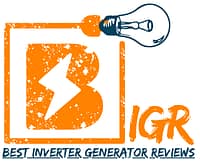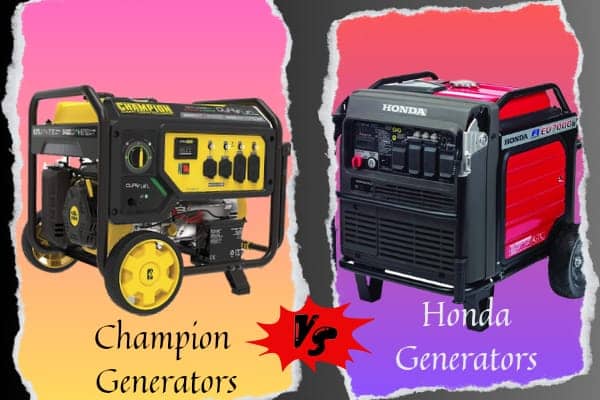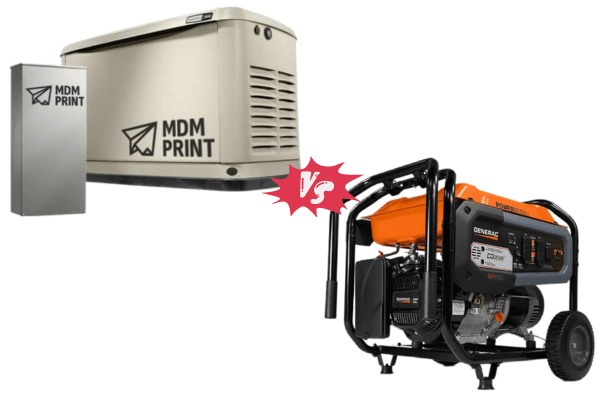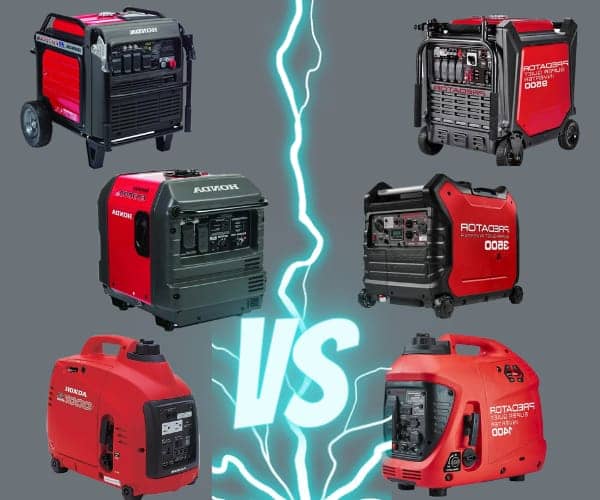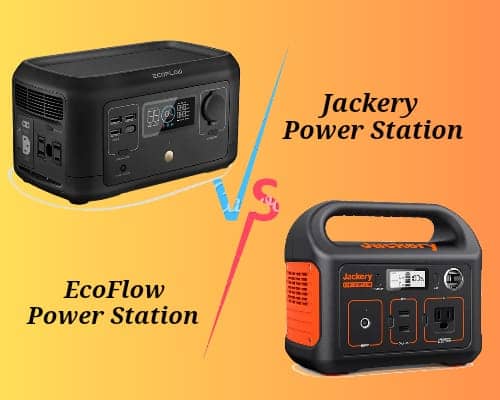
As anyone who spends time in nature or wants backup power security knows, having a reliable power station can be a game changer. But with brands constantly one-upping each other, it can sometimes be made clear who does it best. That’s why I decided to compare both brands in capacity, portability, cost, warranty, customers services, and more.
I aim to provide an impartial comparison to help you choose the brand and model that perfectly fits your needs and budget. Whether you need lightweight power for camping trips or powered appliances for van life, I’ll cut through the marketing to unveil the fundamental differences between these top two brands EcoFlow Vs Jackery.
By the end, you’ll clearly understand which one is perfect for you!
EcoFlow Vs Jackery power stations
EcoFlow
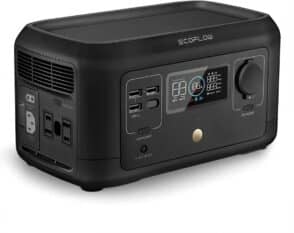
Out with the old, in with the new – that’s the story of portable power station leader EcoFlow. While established brands rest on past tech, it innovates solutions for the eco-minded generation.
Meet the Delta series – from weekend trips to multi-week adventures, it delivers power without compromise—the Delta 1300 charges in a scant two hours via multiple pathways, including solar. Then, run appliances, tools, and toys uninterrupted for days!
Benevolence beyond watts – lithium iron phosphate chemistry means longevity with less environmental cost. Add generous Solar Peak detection; you’ve got a seamless renewable experience everywhere. Their whole home systems bring this versatility indoors, too.
Making off-grid living the new normal, this company delivers convenience once impossible and inspires us toward cleaner energy independence. From their SolarShare project bringing sunlight to refugees, their dedication to the People and Planet brightens all prospects.
Jackery
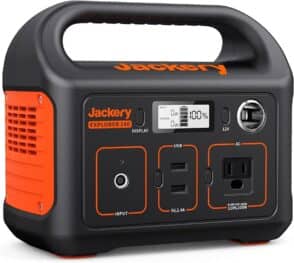
Jackery offers a full range of portable power stations so users can select the model that is perfectly sized to their needs. Whether you need backup power for occasional weekend trips or heavy-duty capacity for extended excursions off the grid, there is an option. The smallest holds enough charge for basic device needs, while larger ones can power home appliances and tools for several days straight.
Another key to their popularity is build quality that stands up to demanding outdoor use. Its stations are praised for sturdy yet lightweight construction that protects sensitive components. Owners enjoy years of reliable runtime, even with frequent charging cycles and travel. The sleek casing seamlessly integrates form and function for protection without bulk.
Where Jackery truly separates itself is the focus on intuitive user experience from the initial setup. Within minutes, you can have power on hand versus fussing with multiple items. Reviewers appreciate the easy-to-read interface, keeping tabs on remaining capacity at a glance. This initial strong connection sets the stage for seamless operation and customized charging solutions on all your adventures.
By offering accessories like solar panels, car chargers and additional batteries, the company empowers users to optimize their portable power solution truly. Whether using clean solar energy or tapping existing power in the vehicle, it’s easy to sustain device needs anytime, anywhere. Such a robust ecosystem ensures the stations stay up to date-and even more valuable as power demands increase over the lifetime of ownership.
Ecoflow Vs Jackery in Capacity
When it comes to raw capacity, EcoFlow has a clear advantage by offering a broader range of options up to monster stations exceeding 4,800Wh. These huge batteries are meant to provide home or job site backup power for multiple days on end. On the other hand, Jackery tends to max out around the 2,000Wh mark, which remains overkill for most recreational vehicle use cases.
That said, even some of EcoFlow’s mid-sized models in the 1,000-2,000Wh echelon will significantly outperform similarly priced Jackery offerings in runtime for power-hungry appliances like refrigerators, microwaves or electric heaters that demand high wattage over many hours. This is simply thanks to their more extensive lithium-ion cell construction, which is able to discharge impressive power levels for prolonged periods.
However, for more reasonable loads posed by devices, gadgets, lights and small electronics numbering in the tens rather than hundreds of watts – many models within the 500-1,000Wh range will provide very similar runtimes. Additionally, Jackery counters its smaller capacities with optimizations, ensuring power is delivered efficiently to connected loads without wastage. This means devices charge at their peak rates without thermal step-downs, which are sometimes seen on larger power stations under stressful conditions.
So, while EcoFlow may have the outright numbers advantage, Jackery crafts a refined user experience better suited for medium-sized tasks like weekend camping, tailgating or essential office outage protection where you value sustained power quality over sheer unbridled capacity. Both certainly have their merits depending on individual power needs and style of operations.
Let’s take a closer look at the capacity of both models
If you’re talking heavy-duty power that can last for days, EcoFlow’s monsters like the Delta Pro, with its expandable 25kWh capacity, are truly in a league of their own. I mean, we’re talking enough juice to run full-size appliances, HVAC units, you name it. You’d be set up for a weekend festival or serious job site work.
Of course, all that power comes at a severe price. For most recreational use cases, more modestly sized units offer fantastic value. Take the Delta Max 2000 – with over 2,000 watt hours plus the ability to expand to 6,000+, it’ll run anything you need around the campsite or work truck without breaking the bank.
Jackery also delivers considerable power at slightly smaller scales. The new Explorer 3000 Pro hitting the scene next year promises over 3,000-watt hours to handle tools, medical gear, and even fridges with room to spare. Meanwhile, the Explorer 2000 Pro runs high-watt appliances like A/C or power tools with over 2,100-watt-hour capacity.
And if you don’t need “pro” power levels, more compact options deliver. The Explorer 1000 and River Pro are genius for on-the-go use, fitting in smaller spaces but still offering plenty of watts for essential gear from lights to blenders. Even the pint-sized Explorer 500 keeps things powered up in actual campsite MVP fashion.
Ecoflow Vs Jackery in Portability
When transporting portable power stations, weight is a significant consideration. Both offer reliable options, but they differ significantly in how mobile their highest-capacity models are.
Let’s look at the weight stats. The most potent EcoFlow station is the Delta Pro at 60 pounds. The Jackery Explorer 3000 Pro tops out at just over 22 pounds. That’s a substantial 38-pound difference between these two industry-leading models!
You noted that EcoFlow attempted to counter the Delta Pro’s heavyweight with wheeled design. And it’s true – the extendable handle and swivel casters make the Delta Pro much more accessible to roll around than if it was just a bare unit. But at over 50 pounds, it’s still a hefty device to wheel up steps or in and out of vehicles compared to the Explorer 3000 Pro.
Both brands are more comparable with their mid-range and entry-level power stations. Models like the EcoFlow River Pro and Jackery Explorer 500 weigh within a few pounds of each other. So, for occasional use or lighter loads, either brand could suffice regarding portability.
But when you need to transport the maximum power and capacity these brands offer regularly, Jackery has a clear advantage. Hiking long distances or taking a power station in and out of camp frequently, that weight savings of lugging 23 pounds vs nearly 60 pounds starts to add up fast! Crews working on job sites all day would surely appreciate not having to carry and wrangle an extra 35+ pounds of gear jointly.
EcoFlow vs Jackery in Efficiency
When selecting a portable power solution, one of the most important factors is the battery management system (BMS) and how efficiently it can control charging and discharging. Both companies are industry leaders known for their innovative BMS technologies, but some key differences are worth exploring.
Let’s start with EcoFlow. Their BMS utilizes cell-level monitoring, allowing real-time tracking of each battery cell. This level of precision is designed to prevent overcharging, overheating, or any cell from getting too out of balance with the others. The BMS also includes temperature regulation that actively adjusts the battery temperature for optimal performance and safety. Through EcoFlow’s app, users get complete visibility of statistics on their power station’s status.
Temperature control is crucial for efficiency and battery lifespan. By actively balancing temperature, cells don’t degrade prematurely from heat. The monitoring at a granular level also ensures no single cell fails prematurely from excess wear. Combined, these EcoFlow features should maximize energy capacity over time.
While Jackery’s BMS doesn’t offer cell-level tracking like EcoFlow, it still includes essential protection layers. There is overvoltage, over-current, and short-circuit protection to shield the battery and connected devices for safety. Additionally, Jackery uses an intelligent cooling fan that automatically adjusts speed based on the interior temperature. Like EcoFlow, this thermal regulation helps maintain optimal conditions for the power cells.
Both systems are designed with safety and longevity in mind. But EcoFlow’s more precise cell-by-cell approach could deliver some unique advantages. Finer temperature controls and imbalance alerts at that level can extend total battery life through more even wear. The data visibility also empowers users to optimize usage habits over time.
When picking between brands strictly for BMS tech, though, you can feel confident with either. Both incorporate measures to prevent damage from misuse and overheating, which is critically important. And both aim to maximize usable capacity, especially as the market heats up for repeat customers. With new features always in the works, both brands deliver innovation that benefits users.
Ecoflow Vs Jackery in Accessories
Another factor to consider when choosing a portable power solution is the entire ecosystem of accessories available to optimize your setup. Both offer vast arrays of add-ons, but there are some notable differences to point out.
Let’s start with solar charging options. This is an essential accessory for true off-grid power. EcoFlow has a more extensive line of solar panels ranging from 110W up to 400W panels in their highest voltage options. This gives users more flexibility to find the right size for various use cases and power needs. Meanwhile, Jackery’s smaller panels max out at 200W.
Regarding adapters, both brands offer 12V car chargers, AC wall chargers, and specialized cables. EcoFlow includes more wattage choices with their car chargers and sells an EV-specific adapter for electric vehicles like Teslas. Jackery’s charger lineup is more straightforward, with single options.
Trending accessories like battery packs are also available for select EcoFlow power stations. This enhances their storage and portability even further by allowing pack additions.
Both brands offer protective cases and bags, too. However, 1st brand has variations like heavy-duty complex cases, while the Jackery case options are more basic. For tasks that require defending devices from harsh environments, the EcoFlow instances stand out.
While the fundamentals are covered across brands, EcoFlow caters its accessories lineup towards maximizing usable energy harvest and storage in more demanding applications. Their higher-wattage solar panels and extra batteries unlock off-grid potential over extended periods. But Jackery’s streamlined options are more affordable if straightforward charging meets your needs. Research is vital to choosing the right ecosystem for any budget or project scope.
EcoFlow Vs Jackery Cost Comparison
When outfitting for portable power, budget is another major factor alongside capabilities. Both offer reliable solutions, but their pricing varies considerably based on features and output. Understanding differences is critical to an intelligent purchasing decision.
Let’s look at current base costs per unit, starting with Jackery. Its popular Explorer 500 runs around $500 and provides 518Wh of energy. Going up to the Explorer 1000 sits at approximately $800 for 1002Wh. Their Pro 3000 model rests at roughly $1,500 for 3,000Wh.
Meanwhile, EcoFlow has a range beginning with the base River at $400 for 372Wh. Their mid-tier River Pro lists for about $700, bringing 720Wh. Then their more robust Delta Pro sits at $2,000, delivering 3.6kWh when paired with an extra battery pack.
EcoFlow’s numbers trend higher even at baseline, though they offer granular functionality upgrades. Their Delta Pro, for example, provides DC home outlets that are unique in the class. All EcoFlow devices feature faster X-Boost charging, which is absent from many peers.
Extra features filter down adequately to their more affordable models, too. Both River units, for instance, deliver dual USB-C PD ports, a necessity nowadays. The user-friendly EcoFlow app and expansive accessory lineup broaden overall value.
Beyond upfront costs, total ownership factors matter greatly, too. Consider, for example, an average annual increase of only 10% in solar panel efficiency each year. Pairing multiple panels could yield far higher returns on investment with EcoFlow’s flexibility to accept up to four simultaneous solar inputs. Over half a decade, that advantage compounds tremendously versus single pairing options.
EcoFlow’s exclusive ability to accept extra battery packs multiplies adequate capacity for intensive applications. True prosumers pushing their equipment understand that value as few competitors currently offer it.
Then, customer service and warranty quality become major long-term differentiators. As mentioned, EcoFlow’s global certified technician network and free shipping benefits provide reassurance that is difficult to quantify in dollars yet critical for multi-year dependability.
So, while Jackery allows breaking into portable power more affordably, disciplined research reveals EcoFlow introduces efficiency and self-reliance upgrades that streamline off-grid productivity in a way that justifies their premium. Total lifetime expenses matter most to discerning pro users, making EcoFlow a sound investment.
EcoFlow Vs Jackery Customer Service
When investing in a portable power solution, having strong customer support is essential should any issues arise during or after the purchase process. Both understand the importance of keeping customers happy, but how do they compare in this crucial aspect?
Let’s examine the options. EcoFlow provides 24/7 live chat on their website for quick inquiries anytime. Customers can also submit support tickets through email if conversation isn’t preferred. It has dedicated phone representatives available during standard business hours for more complex matters. Overall, their response times through various channels are usually very prompt based on buyers’ reviews.
Jackery offers similar access through live chat, email ticketing, and a toll-free phone line during business hours. However, some customer reviews note chat isn’t accessible as late into the evening compared to EcoFlow. And response speed through email may take a few hours longer on average versus live chat with EcoFlow. Still, the majority of Jackery customers say issues are ultimately resolved satisfactorily.
Regarding warranty support, both brands back their products with 2-year protection plans. Any manufacturing defects will be repaired or replaced within that window. However, EcoFlow provides free shipping both ways on repairs, while reviews mention that Jackery sometimes charges for the return trip on large items. For international customers, Eco also has broader global coverage options that may be more convenient than shipping items back to the US for support.
The biggest differentiator is EcoFlow’s certified technician program. This network of local experts can handle repairs and technical support on-site in many countries versus shipping items long distances. Customers appreciate the convenience this added level of service provides, especially for businesses relying on equipment uptime.
EcoFlow Vs Jackery in Warranty
When making a sizable investment in a portable power solution, a strong warranty is essential to protect customers from any potential defects or issues. Both aim to provide reassurance through their standard coverage plans.
As is expected, each brand offers a 2-year limited warranty for the original purchaser. During this period, any manufacturer defects will be repaired or replaced free of charge. This gives customers at least two seasons of carefree use without worry.
EcoFlow then allows coverage extension of up to three years through their paid Extended Warranty program. This helps future-proof an investment for half a decade or more of service life. However, the added cost may only suit some budgets.
Meanwhile, Jackery’s VIP Warranty stands out as offering one unique benefit. For a fee, it provides a one-time replacement should the battery itself begin to falter outside typical capacity loss over time. This extra protection can offer reassurance since the battery is often the most failure-prone component with heavy usage cycles.
Final Verdict
EcoFlow and Jackery are both top brands for portable power stations. Each has its strengths depending on needs.
Jackery takes the prize for portability, offering lightweight and affordable options perfect for casual users on the go. However, their power capacities max out compared to heavy-duty solutions.
EcoFlow leads for high-powered stations able to run appliances and back up homes off-grid. But weight and price are compromises, making them less convenient for frequent transport.
Mid-range capacities or occasional portable power? Either brand suits well, though EcoFlow often runs discounts, making costs similar.
Serious off-grinder powering appliances will prefer EcoFlow’s expandable batteries and power. But the Explorer 3000 Pro still provides excellent value on a tighter budget than full-featured EcoFlow models.
